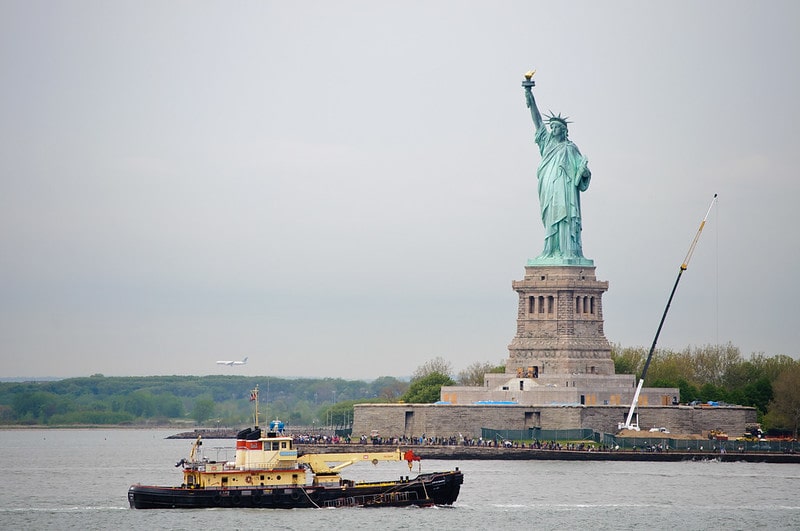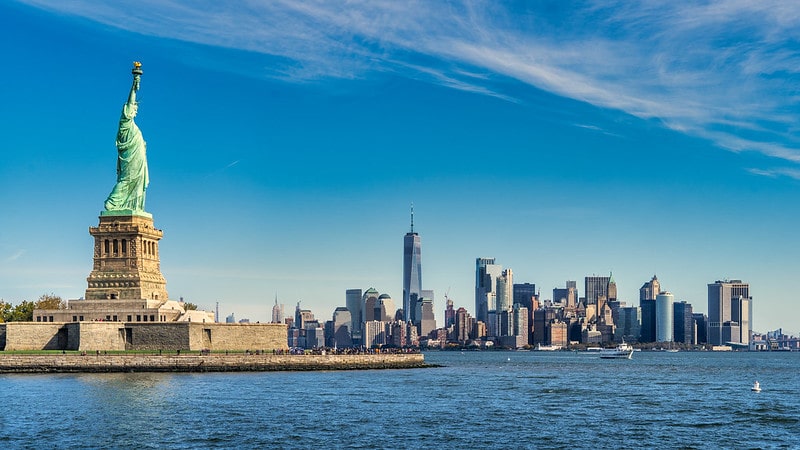Last updated on October 10th, 2021
The Statue of Liberty is one of the most famous landmarks in the world. Show an image of the statue to anyone from the Far East, Europe, or Australia and they will readily recognize it as the symbol for the United States of America. The Statue of Liberty has stood tall for over 145 years, beckoning to countless numbers of people who have come to her shores. The fascination about her continues to this day and for many great reasons. Here are 50 interesting facts about the Statue of Liberty that you ought to know.
1. As American as the Liberty Statue is, did you know that it was not even an American who designed her or inspired her shape and form?
2. The real name of the Statue of Liberty is Liberty Enlightening the World. However, she is more often referred to as Lady Liberty. She is the oldest statue in the United States, besting the Abraham Lincoln statue by 34 years.

3. The Statue of Liberty may appear from afar as if she is standing still but her right foot is actually in mid-stride, which means she is moving forward. This is meant to represent her leading the way towards freedom.
4. The statue was designed by Frederic Auguste Bartholdi, a French sculptor. Bartholdi tried to pitch a similar structure to another country but the deal did not push through. A few design tweaks later of what would become the Statue of Liberty was presented to the U.S. as a way to commemorate the centennial of independence of the United States and celebrate the country’s friendship with Bartholdi’s native France. The U.S. and France were allies during the Revolutionary War.
5. The statue is the product of crowdsourcing. Although the statue was paid for by the French government, its pedestal needed funding. Efforts to raise money for the stand were largely unsuccessful and even the American Congress could not come up with a feasible funding package. Thanks to the efforts of Joseph Pulitzer, the famed publisher of The New York World, a fundraising campaign helped complete the amount needed to pay for the statue’s pedestal.
6. Pulitzer’s campaign raised the last $100,000 needed for the $250,000 pedestal. The actual amount collected was actually $101,091 which came from over 160,000 donors who consisted of businessmen, politicians, street cleaners, and even children.

7. The statue is made up of 250,000 lbs. of steel and 62,000 lbs. of copper. The pedestal, which is made of concrete weighs a whopping 54 million lbs.
8. The statue is impressive for its height but in reality, it is actually only 151 feet tall. The reason why it looks taller is because of the pedestal she is standing on, which is 154 feet tall. That makes the tip of the torch that Lady Liberty holds standing high at 305 feet from the ground.
9. Bartholdi chose Bedloe’s island as the place where the Statue of Liberty would stand during his initial visit to the U.S. Bedloe’s Island, renamed Liberty Island in 1956, was chosen not for its size (just 14.71 acres) but for its location. Liberty Island is right in the Upper New York Bay and every ship that enters the harbor of New York could see it. It was the perfect spot for the Statue of Liberty.
10. Bartholdi presented his idea of the statue as early as 1871, when he traveled to the U.S. for the first time. The idea was originally shared to Bartholdi by Edouard Rene de Laboulaye, who was a French poet, author, and friend of the sculptor.
11. The stoic, determined face of the statue was rumored to have been modeled after Bartholdi’s mother, Charlotte Beysser Bartholdi. However, the sculptor never confirmed this. Some sources believe it may have been modeled after his troublesome brother instead. The torso and the arms, however, were modeled after his wife’s form.
12. The statue is made of copper that is 3/32 inch thick. The parts are held together with lead and tin.

13. The statue was shipped to the U.S. from France disassembled into 350 different pieces that required 214 crates to store. When she reached New York, it took four months to put her together. However, building the statue itself took nine years.
14. Lady Liberty may appear green now but it wasn’t so when she was first assembled. The copper plates that make up her exterior were a dull reddish brown color. The plates gradually turned green because of oxidation. This process created a patina of copper carbonate, a layer that also helps protect the metal from progressive decay due to corrosion.
15. The statue achieved her current patina of green over 35 years, starting from the time she was assembled. Oddly enough, her creators did not realize that the copper material would change color over time.
16. The statue has a crown with seven points, each of which represents the seven continents and the seven seas. It may also represent the seven different freedoms: civil, moral, national, natural, personal, political, and religious.
17. The crown is accessible to the public. There are tickets to the crown that can be bought from Statue Cruises or authorized third parties. However, people usually have to book in advance due to the popularity of the tour. On not-so-busy days, it may be possible to get an entry ticket by simply showing up but this is not recommended on busy days.

18. Visitors to the Statue of Liberty may climb up to enjoy the view from the crown, which has 25 windows. They have to climb 363 steps to reach the top. The climb is actually safe although it is a bit steep, especially the part where the steps turn into a double-helix staircase near the top.
19. People who climb the Statue of Liberty can not expect any elevators or staff assistance. Because climbing it is like going up a 27-storey building, the activity is only recommended to those who are fit or moderately healthy at the very least. Children younger than 8 are not allowed in.
20. Because of her height and the material the statue is made of, lightning does strike her multiple times each year.
21. Although the Statue was designed by Bartholdi, the inner structure was built by Gustave Eiffel – the same man who built the famous tower that bears his name.
22. Before becoming involved in the making of the statue, Gustave Eiffel was an engineer who built bridges. He disliked the idea of putting copper plates over his work because he considered the cladding ugly. This assignment may have inspired him, however, because after completing the structure, he proposed the construction of the Eiffel Tower.
23. The Statue is not a solid structure. Underneath the solid-looking exterior is a pylon tower. The exterior of the Statue, along with its head and arms were built in the Gaget, Gauthier, & Co. workshop. The tower was built in a separate location, Eiffel’s workshop.

24. The torch of the Statue was more than just a symbol. In its early years it actually served as a lighthouse that ships coming into the New York harbor used as a navigational aid. Unfortunately, there was a miscalculation with the angle by which the lights were supposed to shine. On the first night the lights were turned on, they shone at an angle that kept part of the Statue in the dark, from its shoulders to its head.
25. When its function as a lighthouse was improved, the torch was equipped with nine electric lamps. When turned on, the lights were visible as far as 24 miles out to sea. The Statue was the first American lighthouse to use electricity. All others were powered by kerosene.
26. The torch was accessible until 1916, when the Black Tom explosion occurred. On July 30th of that year during WWI, an explosion sent flying debris that damaged the Statue’s arm and torch. It was an act of sabotage instigated by Germany.
27. The torch is not the original component from 1886. In 1984, renovations by the National Park Service included replacement of the torch. The new beacon is composed of unbroken copper and was covered using 24k gold leaf.
28. The torch can still be visited but only by NPS staff. Since it features 16 floodlights, the torch has to be maintained from time to time. The NPS staff has to climb a 40-foot ladder to access the torch. It is off limits to visitors.
29. No one other than staff may be allowed in the torch but the view from there can still be enjoyed via the TorchCam. The camera was installed in 2011 and has been livestreaming since.

30. The Statue was dedicated on October 28, 1886. The occasion was celebrated with a massive fireworks display and a ticker tape parade which was the very first ever in New York.
31. During the statue’s opening day, she was met with protests from the suffragists. They rallied against the image of a woman that supposedly symbolized freedom because at the time women still did not have the right to vote. They only won this right 34 years later.
32. On March 1, 1902, the Statue of Liberty stopped working as a lighthouse or navigational aid. Although the headkeeper tried to keep the cost of upkeep down, the Statue proved to be too expensive to maintain. From the time it started to the time the War Department requested the Lighthouse Board to give up its jurisdiction over the structure, the Statue only had one headkeeper, Albert E. Littlefield.
33. The Statue moves! Well, sort of. The Statue is not a solid structure. Inside it is a skeleton made of steel and iron pylon, constructed in such a way to allow the copper exterior pieces to move independently. This helps keep the Statue intact even when it is hit by strong winds in the harbor.
34. The Statue was also referred to as the “Mother of Exiles”. This phrase comes from a sonnet by Emma Lazarus titled, “The New Colossus”. Lazarus wrote the sonnet to help raise funds to construct the pedestal for the Statue in 1883. It was one of several literary works written for the Art Loan Fund Exhibition for the pedestal and the first entry that was read at the opening of the exhibit in 1883.
35. Although the sonnet, “The New Colossus” now appears on a plaque attached to the Statue’s pedestal, it was once a forgotten work. It was not even included when the Statue was unveiled in 1886. A friend of Lazarus’ named Georgina Schuyler rediscovered the poem in a bookshop in 1901 and decided to help create interest in the work. In 1903, the poem was finally inscribed in a plaque that millions of visitors have since seen and read. The plaque, incidentally, is a casting and not an engraving, although it is described as such.
. . . continue reading on the next page
